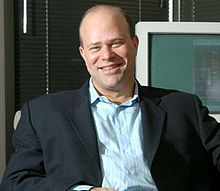David Tepper grew up poor in Pittsburgh, Pennsylvania and had the desire and drive to become rich from a young age. He merged himself in learning and education and wanted to graduate from college in three years to not only save time but money.
Tepper started trading during college to pay for his tuition. He was very good at math and saw an opportunity in the options market as they were not efficient in pricing in changes based on the underlying stock fast enough early on when he started trading. He was very successful in his option arbitrage trading and was able to use the profits to pay for his college education.
He earned an MBA degree from Carnegie Melon University and got a job in the treasury department at Republic Steele. It was there he was first introduced to the junk bond market. Tepper realized early he had a great skill in also trading junk bonds. His ability of successfully trading in junk bonds created the opportunity to land a job working for Goldman Sachs.
During the 1987 Black Monday stock market crash almost every trader at Goldman Sachs except David Tepper. Tepper was short during the crash and made a lot of money while others were losing a lot or even being ruined with losses. He was not well liked at Goldman and did not make partner. Not happy at Goldman Sachs, Tepper started trading aggressively with his own account.
How did David Tepper make his money?
After he was passed over for partner many times he decided to leave. In 1993, Tepper used his connections made at Goldman Sachs to raise $57 million in capital and found his own hedge fund Appaloosa Management. He enjoyed striking out on his own and said it made his life better in so many ways.
In 1995, Tepper bought Argentine bonds near the bottom right before the country rebounded, earning a 30% return for the fund that year. His style is of a deep value investor looking for something very undervalued and betting on it going up and returning closer to its intrinsic value.
Appaloosa had great returns until 1998, when Tepper lost $80 million betting on Russian bonds before they defaulted. Incredibly, Tepper bought back Russian bonds after the default in 1999 at five cents on the dollar. He made 61% on that trade making back his previous losses and even ended up positive on the Russian bond trade.
In 2001, Appaloosa returned 67% by focusing on distressed bond trades. Tepper would invest and trade anything he thought was undervalued in the short term or long term. He would hold investments in companies he thought were a great value.
Appaloosa was down -28% in 2008. Even then he believed his losses were only temporary and saw a lot of undervalued opportunities in the market after the financial crises crashed the markets. After the credit crises he began buying all the common, preferred, and junior subordinated debt he could get his hands on.
Paying as little as 5 cents on the dollar for the debt of AIG, Bank of America, and Citigroup. His bets paid off huge, making him a 330% return on B of A debt, 220% on Citi debt, and he made $1 billion in profits from the AIG debt purchase.[2]
In 2009, Tepper’s hedge fund also earned approximately $7 billion by buying distressed financial stocks in February and March (including Bank of America common stock at $3 per share as one example), and then profiting from the stock market recovery later that year.[3]
How did David Tepper become a billionaire?
David Tepper’s Appaloosa Management is one of the most successful hedge funds of all time, earning net gains of $30.70 billion for its investors since the fund’s inception in 1993 according to a report released by LCH Investments.[3] The fees he earned and his share of profits for money management made him a billionaire.
The average returns from the Appaloosa hedge fund he founded stands around 25% a year since inception through 2019. David Tepper is planning on converting his hedge fund into a family office.[4]
Tepper has been steadily winding down his fund and returning capital to clients in recent years.[5]
David Tepper Strategy
Here are tips for investing and trading like David Tepper.
- He always enters a position with a large margin of safety. The remaining downside is limited.
- Tepper doesn’t use leverage in his investing and trading. His risk is limited to his capital in a position.
- He must understand why something is undervalued and see the edge.
- Tepper is an event driven trader looking for catalysts and news for entries and exits.
- He must see how the value will be realized in the future for an asset.
He’s a deep value investor, he buys when their is blood in the streets, and looks for things very oversold in price and value and have a high probability of not going to zero but instead reverting to the historical mean in price versus value.
What is David Tepper’s net worth?
David Tepper’s current net worth in 2022 is $18.5 billion according to Forbes. He’s currently the 79th richest person in the world. Tepper’s path to becoming one of the richest people in the world was through managing capital.
He grew rich through his skills of trading and investing with the leverage of other people’s capital and compounding his fund’s growth of assets under management by making his investors richer and attracting more money. His fees and share of profits from investors in his fund made him incredibly wealthy over the years.
While he doesn’t use leverage in his investing to avoid the risk of ruin, he did use the leverage of other people’s money to make him rich.
Tepper’s Appaloosa Management hedge fund has purposely decreased its assets under management to $13 billion, down from a peak of $20 billion as he converts his fund to a private family office as he slowly retires from the money management business.
He moved from New Jersey to Florida in 2016 and relocated his hedge fund firm and operations there.
In 2018, Tepper bought the Carolina Panthers National Football League team in a $2.3 billion deal.

